《英国文学史及选读》
- 格式:doc
- 大小:541.00 KB
- 文档页数:58
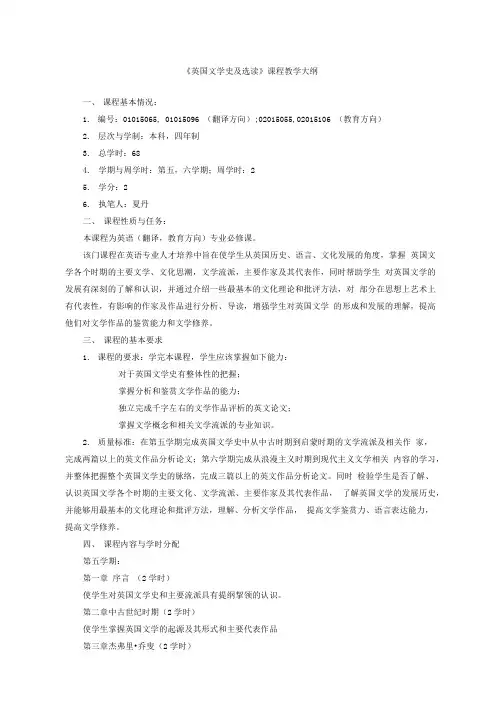
《英国文学史及选读》课程教学大纲一、课程基本情况:1.编号:01015065, 01015096 (翻译方向);02015055,02015106 (教育方向)2.层次与学制:本科,四年制3.总学时:684.学期与周学时:第五,六学期;周学时:25.学分:26.执笔人:夏丹二、课程性质与任务:本课程为英语(翻译,教育方向)专业必修课。
该门课程在英语专业人才培养中旨在使学生从英国历史、语言、文化发展的角度,掌握英国文学各个时期的主要文学、文化思潮,文学流派,主要作家及其代表作,同时帮助学生对英国文学的发展有深刻的了解和认识,并通过介绍一些最基本的文化理论和批评方法,对部分在思想上艺术上有代表性,有影响的作家及作品进行分析、导读,增强学生对英国文学的形成和发展的理解,提高他们对文学作品的鉴赏能力和文学修养。
三、课程的基本要求1.课程的要求:学完本课程,学生应该掌握如下能力:对于英国文学史有整体性的把握;掌握分析和鉴赏文学作品的能力;独立完成千字左右的文学作品评析的英文论文;掌握文学概念和相关文学流派的专业知识。
2.质量标准:在第五学期完成英国文学史中从中古时期到启蒙时期的文学流派及相关作家,完成两篇以上的英文作品分析论文;第六学期完成从浪漫主义时期到现代主义文学相关内容的学习,并整体把握整个英国文学史的脉络,完成三篇以上的英文作品分析论文。
同时检验学生是否了解、认识英国文学各个时期的主要文化、文学流派、主要作家及其代表作品,了解英国文学的发展历史,并能够用最基本的文化理论和批评方法,理解、分析文学作品,提高文学鉴赏力、语言表达能力,提高文学修养。
四、课程内容与学时分配第五学期:第一章序言(2学时)使学生对英国文学史和主要流派具有提纲挈领的认识。
第二章中古世纪时期(2学时)使学生掌握英国文学的起源及其形式和主要代表作品第三章杰弗里•乔叟(2学时)使学生对史诗《贝奥武甫》和杰弗里•乔叟的作品思想内容和艺术特色具有深入认识。
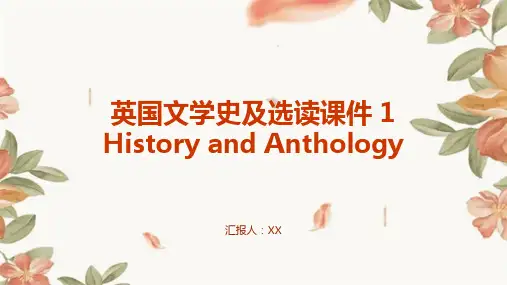
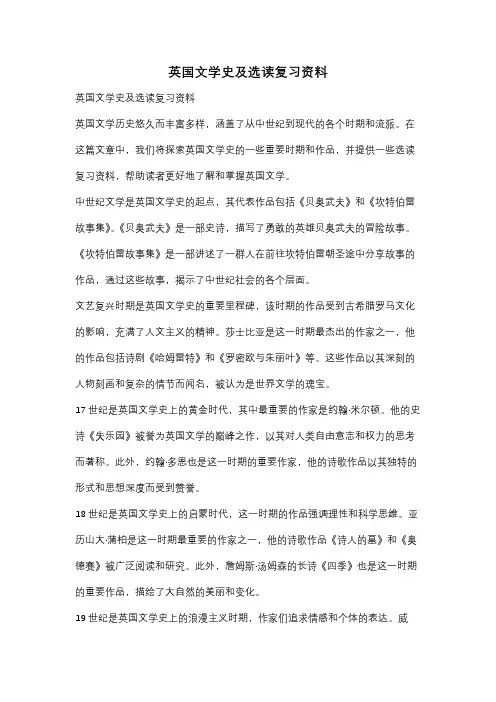
英国文学史及选读复习资料英国文学史及选读复习资料英国文学历史悠久而丰富多样,涵盖了从中世纪到现代的各个时期和流派。
在这篇文章中,我们将探索英国文学史的一些重要时期和作品,并提供一些选读复习资料,帮助读者更好地了解和掌握英国文学。
中世纪文学是英国文学史的起点,其代表作品包括《贝奥武夫》和《坎特伯雷故事集》。
《贝奥武夫》是一部史诗,描写了勇敢的英雄贝奥武夫的冒险故事。
《坎特伯雷故事集》是一部讲述了一群人在前往坎特伯雷朝圣途中分享故事的作品,通过这些故事,揭示了中世纪社会的各个层面。
文艺复兴时期是英国文学史的重要里程碑,该时期的作品受到古希腊罗马文化的影响,充满了人文主义的精神。
莎士比亚是这一时期最杰出的作家之一,他的作品包括诗剧《哈姆雷特》和《罗密欧与朱丽叶》等。
这些作品以其深刻的人物刻画和复杂的情节而闻名,被认为是世界文学的瑰宝。
17世纪是英国文学史上的黄金时代,其中最重要的作家是约翰·米尔顿。
他的史诗《失乐园》被誉为英国文学的巅峰之作,以其对人类自由意志和权力的思考而著称。
此外,约翰·多恩也是这一时期的重要作家,他的诗歌作品以其独特的形式和思想深度而受到赞誉。
18世纪是英国文学史上的启蒙时代,这一时期的作品强调理性和科学思维。
亚历山大·蒲柏是这一时期最重要的作家之一,他的诗歌作品《诗人的墓》和《奥德赛》被广泛阅读和研究。
此外,詹姆斯·汤姆森的长诗《四季》也是这一时期的重要作品,描绘了大自然的美丽和变化。
19世纪是英国文学史上的浪漫主义时期,作家们追求情感和个体的表达。
威廉·华兹华斯和塞缪尔·泰勒·柯勒律治是浪漫主义诗歌的代表作家,他们的作品强调对自然和内心世界的关注。
此外,查尔斯·狄更斯是这一时期最重要的小说家之一,他的作品《雾都孤儿》和《双城记》等揭示了当时社会的不公和人性的复杂性。
20世纪是英国文学史上的现代主义时期,作家们挑战传统文学形式和观念。
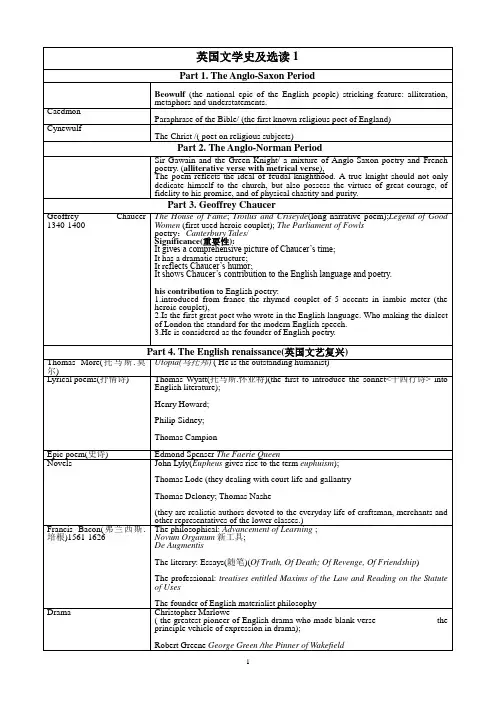
英国文学史及选读1Part 1. The Anglo-Saxon PeriodBeowulf (the national epic of the English people) stricking feature: alliteration, metaphors and understatements. CaedmonParaphrase of the Bible/ (the first known religious poet of England) Cynewulf The Christ /( poet on religious subjects)Part 2. The Anglo-Norman PeriodSir Gawain and the Green Knight/ a mixture of Anglo-Saxon poetry and French poetry. (alliterative verse with metrical verse ), The poem reflects the ideal of feudal knighthood. A true knight should not only dedicate himself to the church, but also possess the virtues of great courage, of fidelity to his promise, and of physical chastity and purity.Part 3. Geoffrey Chaucer Geoffrey Chaucer 1340-1400The House of Fame ; Troilus and Criseyde (long narrative poem);Legend of Good Women (first used heroic couplet); The Parliament of Fowls poetry :Canterbury Tales / Significance(重要性): It gives a comprehensive picture of Chaucer’s time ; It has a dramatic structure; It re flects Chaucer’s humor ; It shows Chaucer’s contribution to the English language and poetry. his contribution to English poetry: 1.introduced from france the rhymed couplet of 5 accents in iambic meter (the heroic couplet), 2.Is the first great poet who wrote in the English language. Who making the dialect of London the standard for the modern English speech. 3.He is considered as the founder of English poetry. Part 4. The English renaissance(英国文艺复兴)Thomas More(托马斯.莫尔) Utopia(乌托邦) ( He is the outstanding humanist) Lyrical poems(抒情诗) Thomas Wyatt(托马斯.怀亚特)(the first to introduce the sonnet<十四行诗> into English literature); Henry Howard; Philip Sidney; Thomas Campion Epic poem(史诗) Edmond Spenser The Faerie Queen Novels John Lyly(Eupheus gives rise to the term euphuism ); Thomas Lode (they dealing with court life and gallantry Thomas Deloney; Thomas Nashe (they are realistic authors devoted to the everyday life of craftsman, merchants and other representatives of the lower classes.) Francis Bacon(弗兰西斯.培根)1561-1626 The philosophical: Advancement of Learning ; Novum Organum 新工具; De Augmentis The literary: Essays(随笔)(Of Truth, Of Death; Of Revenge, Of Friendship ) The professional: treatises entitled Maxims of the Law and Reading on the Statute of Uses The founder of English materialist philosophy Drama Christopher Marlowe ( the greatest pioneer of English drama who made blank verse the principle vehic le of expression in drama); Robert Greene George Green /the Pinner of WakefieldWilliamShakespeare1564-1616 (37plays, two narrative poems, 154sonnets) The Tempest暴风风雨;The Two Gentlemen of Verona维罗纳二绅士;The Mercy Wives of Windsor温莎的风流妇人;Measure for Measure恶有恶报;The Comedy of Errors错中错;Much Ado about Nothing无事自扰;Love’s Labour’s Lost空爱一场;A Midsummer Night’s Dream仲夏夜之梦;The Merchant of Venice威尼斯商人;As You Like It如愿;The Taming of the Shrew驯悍记;All’s Well That Ends Well皆大欢喜;Twelfth Night第十二夜;The Winter’s Tale冬天的故事;The Life and Death of King John/Richard the Second/Henry the Fifth/Richard the Third约翰王/理查二世/亨利五世/理查三世;The First/Second Part of King Henry the Fourth亨利四世(上、下);The First/Second/Third Part of King Henry the Sixth亨利六世(上、中、下); The Life of King Henry the Eighth亨利八世;Troilus and Cressida脱爱勒斯与克莱西达;The Tragedy of Coriolanus考利欧雷诺斯;Titus Andronicus泰特斯·安庄尼克斯;Romeo and Juliet罗密欧与朱丽叶;Timon of Athens雅典的泰门;The Life and Death of Julius Caesar;朱利阿斯·凯撒;The Tragedy of Macbeth麦克白;The Tragedy of Hamlet哈姆雷特/王子复仇记;King Lear李尔王;Othello奥塞罗;Antony and Cleopatra安东尼与克利欧佩特拉;Cymbeline辛白林;Pericles波里克利斯;Venus and Adonis维诺斯·阿都尼斯;Lucrece露克利斯;The Sonnets十四行诗The Great Comedie(伟大的喜剧)s: A Midsummer Night’s Dream; The Merchant of V enice; As You Like It ;Twelfth Night;The Great Tragedies(伟大的悲剧): The Tragedy of Hamlet; Othello; King Lear; The Tragedy of Macbeth;The Later Comedies(romances): Pericles; Cymbeline; The Winter’s Tale; The Tempest;Part 5. The English Bourgeois revolution period and RestorationJohn Milton1608-1674 Shorter poems: L‘Allegro欢乐的人;Il Penseroso沉思的人;Comus科马斯;Lycidas;Principle pamphlets: Areopagitica论出版自由; Eikonoklastes; Defense for theEnglish people;Poem: Paradise Lost (The poem was written in blank verse); Paradise Regained;John Bunyan1628-1688 The Pilgrim’s Progress(It is the greatest English allegory, its style is simple and biblical)John Donne1572-1631 Poetry(love lyrics & religious poems);Sonnets(The founder of the Metaphysical school of poetry)John Dryden Critic, poet and playwright of restoration periodPart 6. The eighteenth CenturyThe Age of Enlightenment or The Age of ReasonEnlightenment Alexander Pope;Joseph Addison&Richard Steele The Spectator;Jonathan Swift;Daniel Defoe;Henry Fielding;Richard B. Sheridan;Oliver Goldsmith;Edward Gibbon;Samuel JohnsonPope exercised the greatest influence on the 18th century poetry;Swift is the most outstanding personality, Gulliver’s TravelsNeoclassicism John Dryden, Alexander Pope, Jonathan Swift, Joseph Addison, Richard Steele, Henry Fielding, Samuel Johnson, Oliver Goldsmith, Edward Gibbon The Decline & Fall of theRoman Empire Neoclassical poetry, as represented by Dryden, Pope & Johnson, reachedits stylistic perfection during the periodModern Realistic Novel Defoe Robinson Crusoe,Richardson,Fielding, Sterne, Goldsmith, T.G..Smollet’s satirical novel The adventures of Roderick RandomFielding and Smollet are the real founders of the genre of the bourgeois realistic novel in England and Europe.Richardson displays the innermost life of an individual, Pamela or Virtue Rewarded, he History of a Young Lady, The History of Sir Chares GrandionGothic Novel The real originator of English Gothic novel was Horace Walpole Castle of Otranto;Mary Shelley Frankenstein;Ann Radcliff The Mysteries of UdolphoSentimentalism Novels: Laurence Stern Sentimental Journey;Tristram Shandy;Oliver Goldsmith The Vicar of WakefieldPoetry: Thomas Gray’s An Elegy Written in a Country Churchyard;Goldsmith’s The Deserted Village;George Crabbe The VillageSatire Pope , Swift, Richard B. Sheridan School for ScandalPre-Romanticism in poetry, which was ushered in by Percy Macpherson & Chatterton, and represented by William Blake&Robert Burns。
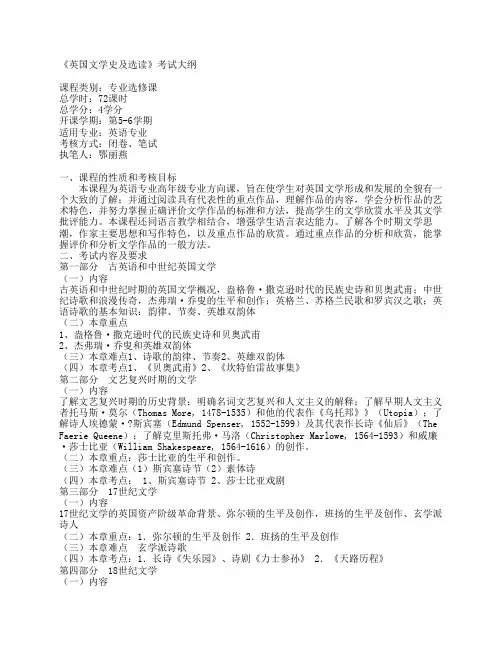
《英国文学史及选读》考试大纲课程类别:专业选修课总学时:72课时总学分:4学分开课学期:第5-6学期适用专业:英语专业考核方式:闭卷、笔试执笔人:鄂丽燕一、课程的性质和考核目标 本课程为英语专业高年级专业方向课,旨在使学生对英国文学形成和发展的全貌有一个大致的了解;并通过阅读具有代表性的重点作品,理解作品的内容,学会分析作品的艺术特色,并努力掌握正确评价文学作品的标准和方法,提高学生的文学欣赏水平及其文学批评能力。
本课程还同语言教学相结合,增强学生语言表达能力。
了解各个时期文学思潮,作家主要思想和写作特色,以及重点作品的欣赏。
通过重点作品的分析和欣赏,能掌握评价和分析文学作品的一般方法。
二、考试内容及要求第一部分 古英语和中世纪英国文学(一)内容古英语和中世纪时期的英国文学概况,盎格鲁·撒克逊时代的民族史诗和贝奥武甫;中世纪诗歌和浪漫传奇,杰弗瑞·乔叟的生平和创作;英格兰、苏格兰民歌和罗宾汉之歌;英语诗歌的基本知识:韵律、节奏、英雄双韵体(二)本章重点1、盎格鲁·撒克逊时代的民族史诗和贝奥武甫2、杰弗瑞·乔叟和英雄双韵体(三)本章难点1、诗歌的韵律、节奏2、英雄双韵体(四)本章考点1、《贝奥武甫》2、《坎特伯雷故事集》第二部分 文艺复兴时期的文学(一)内容了解文艺复兴时期的历史背景;明确名词文艺复兴和人文主义的解释;了解早期人文主义者托马斯·莫尔(Thomas More, 1478-1535)和他的代表作《乌托邦》》(Utopia);了解诗人埃德蒙·?斯宾塞(Edmund Spenser, 1552-1599)及其代表作长诗《仙后》(The Faerie Queene);了解克里斯托弗·马洛(Christopher Marlowe, 1564-1593)和威廉·莎士比亚(William Shakespeare, 1564-1616)的创作。
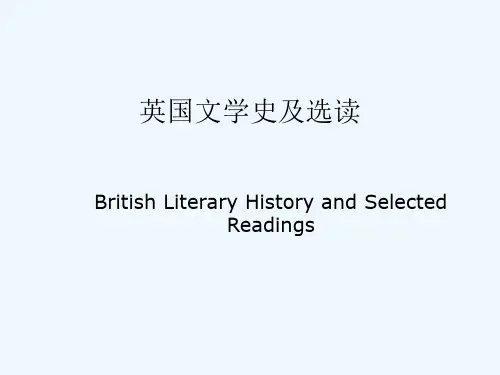
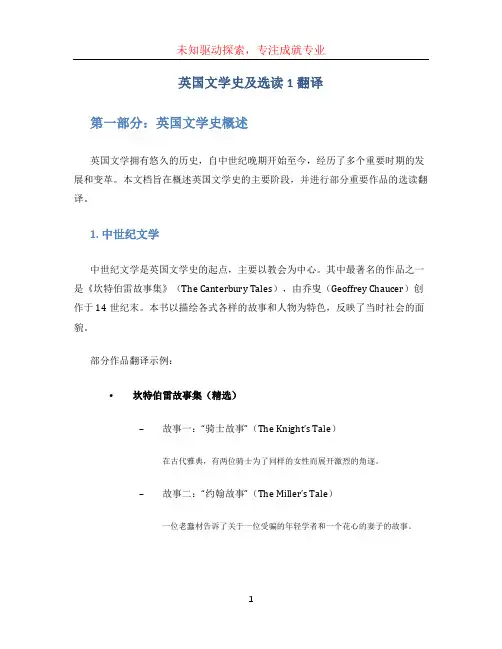
英国文学史及选读1翻译第一部分:英国文学史概述英国文学拥有悠久的历史,自中世纪晚期开始至今,经历了多个重要时期的发展和变革。
本文档旨在概述英国文学史的主要阶段,并进行部分重要作品的选读翻译。
1. 中世纪文学中世纪文学是英国文学史的起点,主要以教会为中心。
其中最著名的作品之一是《坎特伯雷故事集》(The Canterbury Tales),由乔叟(Geoffrey Chaucer)创作于14世纪末。
本书以描绘各式各样的故事和人物为特色,反映了当时社会的面貌。
部分作品翻译示例:•坎特伯雷故事集(精选)–故事一:“骑士故事”(The Knight’s Tale)在古代雅典,有两位骑士为了同样的女性而展开激烈的角逐。
–故事二:“约翰故事”(The Miller’s Tale)一位老蠢材告诉了关于一位受骗的年轻学者和一个花心的妻子的故事。
2. 文艺复兴时期文艺复兴时期是英国文学史上的黄金时期,涌现出许多重要的作家和作品。
莎士比亚(William Shakespeare)是这一时期的代表性人物,他的作品包括戏剧、sonnet 等多种形式。
此外,约翰·密尔顿(John Milton)的《失乐园》(Paradise Lost)也被认为是文艺复兴时期的经典之作。
部分作品翻译示例:•莎士比亚戏剧选读-《哈姆雷特》(Hamlet)-《罗密欧与朱丽叶》(Romeo and Juliet)-《麦克白》(Macbeth)•约翰·密尔顿《失乐园》(选读)探讨人类起源、罪恶和救赎的叙事诗,描述了亚当和夏娃被逐出伊甸园的故事。
3.18世纪启蒙运动18世纪是英国文学史上启蒙运动的时期,以理性和思想自由为核心。
重要的作家包括弥尔顿(John Milton),斯威夫特(Jonathan Swift)和詹姆斯·麦克菲尔(James Macpherson)。
部分作品翻译示例:•斯威夫特《格列佛游记》(选读)这本小说通过一个航海家的冒险旅程,揭示了社会和政治问题,具有强烈的讽刺意味。

英国文学史及选读教案全套教案一:英国文学史概述教学目标:1.了解英国文学史的发展背景和重要时期;2.了解英国文学史上的重要作品和作家;3.培养学生对英国文学发展和作品的分析能力。
教学内容:1.英国文学史的发展背景;2.英国文学史的重要时期和特点;3.英国文学史上的重要作品和作家。
教学步骤:Step 1: 引入教师介绍英国文学史的重要性和意义,并引导学生思考英国文学的特点和影响。
Step 2: 发展背景介绍英国文学史的发展背景,包括古代英国文学的影响,罗马和基督教的进入,以及中世纪和文艺复兴时期的文学发展。
Step 3: 重要时期和特点讲解英国文学史上的重要时期和特点,包括伊丽莎白时代,文艺复兴,浪漫主义,维多利亚时代和现代主义等。
Step 4: 重要作品和作家介绍英国文学史上的重要作品和作家,包括莎士比亚的戏剧,弥尔顿的《失乐园》,狄更斯的小说等。
Step 5: 分组讨论将学生分成小组,每组选取一个重要的时期或作家进行深入研究,并展示给全班。
Step 6: 总结和评价与学生一起总结英国文学史的重要内容和特点,并评价英国文学对世界文学的影响。
教案二:莎士比亚戏剧《哈姆雷特》的选读教学目标:1.了解莎士比亚戏剧的特点和艺术手法;2.理解《哈姆雷特》的情节和主题;3.培养学生对莎士比亚戏剧的分析和解读能力。
教学内容:1.莎士比亚戏剧的特点和艺术手法;2.《哈姆雷特》的情节和主题;3.对《哈姆雷特》的解读和分析。
教学步骤:Step 1: 引入教师引导学生思考莎士比亚戏剧的特点和影响,并激发学生的学习兴趣。
Step 2: 莎士比亚戏剧的特点和艺术手法讲解莎士比亚戏剧的特点和艺术手法,如诗意语言,人物描写和戏剧构思等。
Step 3: 《哈姆雷特》的情节和主题介绍《哈姆雷特》的情节和主题,包括主人公的复仇和道德困境等。
Step 4: 对《哈姆雷特》的解读和分析教师带领学生一起对《哈姆雷特》进行深入解读和分析,如人物形象,意象和隐喻等。
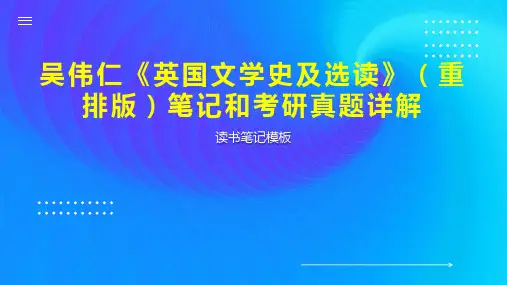
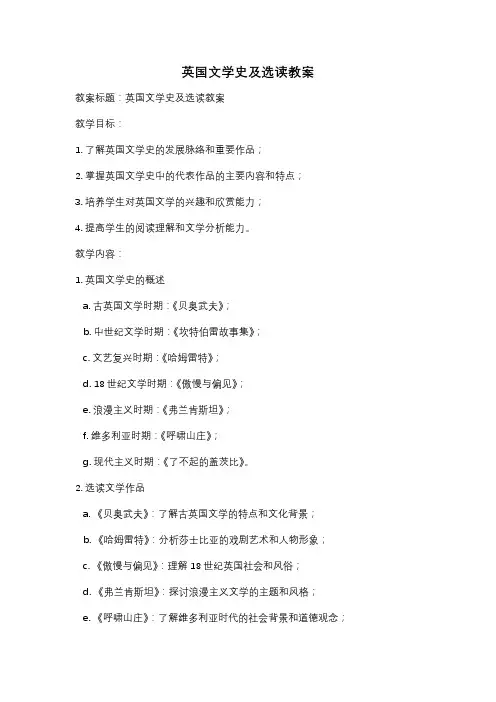
英国文学史及选读教案教案标题:英国文学史及选读教案教学目标:1. 了解英国文学史的发展脉络和重要作品;2. 掌握英国文学史中的代表作品的主要内容和特点;3. 培养学生对英国文学的兴趣和欣赏能力;4. 提高学生的阅读理解和文学分析能力。
教学内容:1. 英国文学史的概述a. 古英国文学时期:《贝奥武夫》;b. 中世纪文学时期:《坎特伯雷故事集》;c. 文艺复兴时期:《哈姆雷特》;d. 18世纪文学时期:《傲慢与偏见》;e. 浪漫主义时期:《弗兰肯斯坦》;f. 维多利亚时期:《呼啸山庄》;g. 现代主义时期:《了不起的盖茨比》。
2. 选读文学作品a. 《贝奥武夫》:了解古英国文学的特点和文化背景;b. 《哈姆雷特》:分析莎士比亚的戏剧艺术和人物形象;c. 《傲慢与偏见》:理解18世纪英国社会和风俗;d. 《弗兰肯斯坦》:探讨浪漫主义文学的主题和风格;e. 《呼啸山庄》:了解维多利亚时代的社会背景和道德观念;f. 《了不起的盖茨比》:分析现代主义文学的特点和主题。
教学步骤:1. 引入:通过图片、音频或视频等媒体展示英国文学史的重要作品和作家,激发学生的兴趣和好奇心。
2. 概述英国文学史的发展脉络,介绍每个时期的特点和代表作品。
3. 分组讨论:将学生分成小组,每个小组负责研究和介绍一个时期的代表作品,包括作品的主要内容、作者的背景和创作意图等。
4. 选读文学作品:分配给学生不同的选读作品,要求他们在课后阅读,并写下自己的阅读感受和分析。
5. 小组分享:每个小组将自己选读的作品进行分享,包括对作品的理解和分析。
6. 教师点评和引导:对学生的分享进行点评和引导,帮助他们深入理解作品的主题和艺术手法。
7. 课堂讨论:就英国文学史的发展和选读作品展开全班讨论,鼓励学生发表自己的见解和观点。
8. 总结:对英国文学史的学习进行总结,回顾每个时期的特点和代表作品,强调文学对社会和历史的影响。
教学评估:1. 课堂参与度:观察学生的积极参与程度,包括讨论、提问和分享。
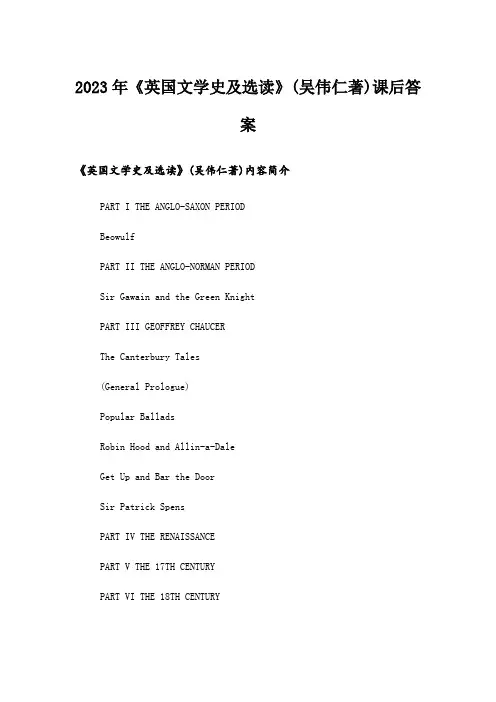
2023年《英国文学史及选读》(吴伟仁著)课后答
案
《英国文学史及选读》(吴伟仁著)内容简介
PART I THE ANGLO-SAXON PERIOD
Beowulf
PART II THE ANGLO-NORMAN PERIOD
Sir Gawain and the Green Knight
PART III GEOFFREY CHAUCER
The Canterbury Tales
(General Prologue)
Popular Ballads
Robin Hood and Allin-a-Dale
Get Up and Bar the Door
Sir Patrick Spens
PART IV THE RENAISSANCE
PART V THE 17TH CENTURY
PART VI THE 18TH CENTURY
《英国文学史及选读》(吴伟仁著)目录
本书是作者根据英国文学历史的`顺序结合作品选读所编写的一套适合我国高等教院校英语专业使用的教材。
由于课时有限,历史部分只作了简明扼要的概述,作品选读部分,尽可能遴选了文学史上的重要作家和重要作品。
这部“史”、“选”结合的教材,分为两册出版,第一册是古代至18世纪英国文学,第二册是19划纪至20世纪英国文学。
教材内容丰富,观点正确,选文具有代表性,可作高校外文系英语专业英国文学史和文学作品选读课程的课本或参考书,也是广大中学英语教师及具有一定程度的英语自学者和英美文学爱好者进修的理想读物。
英国文学史及选读11.H istorical BackgroundCelts 400B.C. Romans 50B.C. Anglo―Saxons 450A.D Norman Invasion 1066A.D. Roman empire从albion撤军,teutonic tribes(包括angles, Saxons,jutes)(条顿人or日耳曼人)陆续登陆此地。
2. Literature 1,pagan异教徒文学2 christian基督徒文学alliterative verse头韵诗Epic: Beowulf贝奥武甫(Denmark背景)(the hall heorot 鹿兀grendel:a monster half-human)1) Oral origin, recited in court, handed down in generations until finally it was recorded by certain poet.上下部分由pagan写,插入由christian写。
2) a mixture of history and legend.,england’s nationalepic 民国史诗诺曼时期1.H istorical BackgroundRoman conquest,接着是english conquest,最后是norman conquest。
The Norman Conquest in 1066Duke William of Normandy claimed himself William I, King of England.(the battle of hastings希斯廷战役)Kings―Barons男爵―Knights, a feudal system of hierarchy统治集团was formed。
2.T he language3.The literatureRomance was a type of literature that was very popularin the Middle Ages. It is about the life and adventures undertaken by a knight.It reflected the spirit of chivalry骑士制度. The content of romance: love, chivalry and religion. It involves fighting, adventures.Subject matter:Geoffrey’s History杰弗里《史记》,riming chronicles押韵编年史,metricalverse格律诗体,doggerel verse打油诗体1)t he Matter of France eg. Charlemagne and his peers查理曼大帝和他的骑士2)M atter of Greece and Rome eg Akexabder亚历山大大帝3)M atter of Britain tales having for their heroes Arthurand his knights of the Round Table3.m ain literatureSir Gawain and the green knight.高文爵士和绿衣骑士(arthur,gawain,green knight, morgain the fay-woman妖精摩根, the green girdle绿腰带)Part III Geoffrey Chaucer (1340―1400)杰弗里.乔叟时期1.H istorical BackgroundThe English won, they controlled large French territory领土. The Henry VI lost it all. He is father of English poetry War of the Roses 1455-1485 AD。
英国文学史及选读学习指南第一册教学设计课程目标本课程旨在介绍英国文学史及相关文本的选读。
通过学习英国文学史的基本框架和重要的文学代表作品,旨在培养学生的文学素养和文学批评能力。
教学内容第一章:英国文学史简介本章内容旨在介绍英国文学史的基本框架,包括文艺复兴时期、启蒙运动时期、浪漫主义运动时期、维多利亚时代和现代主义时期等。
第二章:莎士比亚的四大悲剧选读本章内容旨在介绍莎士比亚的四大悲剧《哈姆雷特》、《奥瑞罗》、《李尔王》和《麦克白》的文学价值和思想内涵。
第三章:简·奥斯汀的小说选读本章内容旨在介绍简·奥斯汀的代表作品《傲慢与偏见》、《理智与情感》等的文学特点和社会背景。
第四章:狄更斯的小说选读本章内容旨在介绍狄更斯的代表作品《雾都孤儿》、《双城记》等的文学价值和社会批判。
教学方法本课程采用多种教学方法,包括讲授、分组讨论、互动答疑等。
教师将通过引导学生分析文学作品的形式和思想内涵,培养学生独立思考和批判性思考能力。
教学评估评估方式包括平时成绩和期末考试成绩。
平时成绩占20%,包括出勤率、课堂表现、课外阅读等;期末考试占80%,考核内容包括英国文学史和文学作品的分析鉴赏能力。
参考文献1.Abrams, M. H. (Ed.). (1999). The Norton anthology of Englishliterature (7th ed., Vol. 1). W. W. Norton & Company.2.Bloom, H. (Ed.). (2004). William Shakespeare’s Hamlet(Bloom’s Modern Critical Interpretations). Chelsea HousePublications.3.Austen, J. (2003). Pride and Prejudice. Penguin Classics.4.Dickens, C. (1998). Oliver Twist. Dover Publications.结语英国文学史及选读课程是人文社会科学类学生必修课程之一。
《英国文学史及选读》.doc
英国文学史及选读,是英国一门著名的文学课程,也是一部经典作品。
它是一部深入
浅出、精睿细腻、全面涵盖的英国文化史,囊括英国近代文学发展脉络,英国文学各时
期最重要的文学作家及作品介绍,从古典文学到浪漫主义文学,正反映了英国文学历史的
变化和发展。
该书的结构紧凑,内容丰富,包括英国人文精神的不同阶段及其代表作家,从古典时
期的莎士比亚到浪漫主义时期的济慈;英国文学发展历史,如抒情主义、自然主义等;英
国文学发展和美学构建的不同时代,从古典文学范式到现代文学范式;文体及技巧;英国
文学作家作品及其研究,如莎士比亚的作品《仲夏夜之梦》、济慈的《傲慢与偏见》,小
说家傅抱石的《兰贝斯特传奇》;英国文学史的主要文本及次要文本的研究,如英国神话、文艺复兴时期的《外乡人》,乔叟的《泶州记事》,英国维多利亚时代的《半口兽语》等。
另外,还有英国文学的传统观念,如文明观念、民族观念、社会观念,宗教观念等,
以及英国文学史上最重要、最有影响力的文学作家,以及他们从事的不同类型文学创作。
以上就是英国文学史及选读对英文文学史发展及特殊文学作家和作品节选以及有关英
国文化史的全面概述。
通过阅读本书,读者可以更深入地了解英国文学史,更好地理解英
国文学及文化发展的历史性、文体性以及要素,拓展文化视野,陶冶人文情怀。
《英国文学史及选读》第一册复习要点1. Beowulf: national epic of the English people; Denmark story; alliteration, metaphors and understatements (此处可能会有填空,选择等小题)2. Romance (名词解释)3. “Sir Gawain and the Green Knight”: a famous roman about King Arthur’s story4. Ballad(名词解释)5. Character of Robin Hood6. Geoffrey Chaucer: founder of English poetry; The Canterbury Tales (main contents; 124 stories planned, only 24 finished; written in Middle English; significance; form: heroic couplet)7. Heroic couplet (名词解释)8. Renaissance(名词解释)9.Thomas More——Utopia 10. Sonnet(名词解释)11. Blank verse(名词解释)12. Edmund Spenser “The Faerie Queene”13. Francis Bacon “essays”esp. “Of Studies”(推荐阅读,学习写正式语体的英文文章的好参照,本文用词正式优雅,多排比句和长句,语言造诣非常高,里面很多话都可以引用做格言警句,非常值得一读)14. William Shakespeare四大悲剧比较重要,此外就是罗密欧与朱立叶了,这些剧的主题,背景,情节,人物形象都要熟悉,当然他最重要的是Hamlet这是肯定的。
他的sonnet也很重要,最重要属sonnet18。
(其戏剧中著名对白和几首有名的十四行诗可能会出选读)15. John Milton 三大史诗非常重要,特别是Paradise Lost和Samson Agonistes。
对于Paradise Lost需要知道它是blank verse写成的,故事情节来自Old Testament,另外要知道此书theme和Satan的形象。
16. John Bunyan——The Pilgrim’s Progress17. Founder of the Metaphysical school——John Donne; features of the school: philosophical poems, complex rhythms and strange images.18. Enlightenment(名词解释)19. Neoclassicism(名词解释)20. Richard Steele——“The Tatler”21. Joseph Addison——“The Spectator”这个比上面那个要重要,注意这个报纸和我们今天的报纸不一样,它虚构了一系列的人物,以这些人物的口气来写报纸上刊登的散文,这一部分要仔细读。
22. Steel’s and Addison’s styles and their contributions23. Alexander Pope: “Essay on Criticism”, “Essay on Man”, “The Rape of Lock”, “The Dunciad”; his workmanship (f eatures) and limitations24. Jonathan Swift: “Gulliver’s Travels”此书非常重要,要知道具体内容,就是Gulliver 游历过的四个地方的英文名称,和每个部分具体的讽刺对象; (我们主要讲了三个地方)“A Modest Proposal”比较重要,要注意作者用的irony也就是反讽手法。
25. The rise and growth of the realistic novel is the most prominent achievement of 18th century English literature.26. Daniel Defoe: “Robinson Crusoe”, “Moll Flanders”, 当然是Robinson Crusoe比较重要,剧情要清楚,Robinson Crusoe的形象和故事中蕴涵的早期黑奴的原形,以及殖民主义的萌芽。
另外注意Defoe的style和feature,另外Defoe是forerunner of English realistic novel。
27. Samuel Richardson——“Pamela” (first epistolary novel), “Clarissa Harlowe”, “Sir Charles Grandison”28. Henry Fielding: “Joseph Andrews”, “Jonathan Wild”, “Tom Jones”第一个和第三个比较重要,需要仔细看。
他是一个比较重要的作家,另外Fielding也被称为father of the English novel.29. Laurence Sterne——“Tristram Shandy”项狄传30. Richard Sheridan——“The School for Scandal”31. Oliver Goldsmith——“The Traveller”(poem), “The Deserted Village” (poem) (both two poems were written by heroic couplet), “The Vicar of Wakefield” (novel), “TheGood-Natured Man” (comedy), “She stoops to Conquer” (comedy), “The Citizen of the World” (collection of essays)32. Sentimentalism(名词解释)33. Thomas Gray——“Elegy Written in a Country Churchyard”(英国诗歌里非常著名的一首,曾经被誉为“有史以来英国诗歌里最好的一首”)(a representative of sentimentalism and graveyard school of poets墓园派诗人)* Graveyard School / Poets”: A term applied to eighteenth-century poets who wrote meditative poems, usually set in a graveyard, on the theme of human mortality, in moods which range from elegiac pensiveness to profound gloom. The vogue resulted in one of the most widely known English poems, Thomas Gray’s “Elegy written in a country churchyard”. The writing of graveyard poems spread from England to Continental literature in the second part of the century and also influenced some American poets.34. In the latter half of the 18th century, Pre-Romanticism; representative: William Blake and Robert Burns.35. Thomas Percy——“Reliques of Ancient English poetry”许多中古的民谣都是在这个时期重新收集和整理起来的,这个集子是那个时代比较有名的一个民谣集。
36. William Blake比较重要,需要对主要作品有所了解,特别是Songs of Innocence 和Songs of Experience, 这两本集子的contrast一定要注意,另外Blake的写作特点也要注意,比如语言的简单明了,神秘主义氛围等。
37. Robert Burns伟大的苏格兰民族诗人, A Red Red Rose, Scots Wha Hae, Auld Lang Syne等名诗,写作特点: Scottish dialect; a poet of peasant and Scottish people; plain language; influence from Scottish folk songs and ballads; musical quality of his poems. 《英国文学史及选读》第二册练习题I. 浪漫主义时期I. Each of the statements below is followed by four alternative answers. Choose the one that would best complete the statement and put the letter in the brackets.1. English Romanticism is generally said to have begun with_____in 1798.A. the publication of Lyrical BalladsB. the death of Sir ScottC. the birth of William WordsworthD. the passage of the first Reform Bill in the Parliament2. The Romantic Period is first of all an age of_____.A. NovelB. poetryC. dramaD. prose3. Romanticism does not emphasize_____.A. the special qualities of each individual’s mindB. the inner world of the human spiritC. individualityD. the features that men have in common4._____ is not a Romantic poet.A. William BlakeB. Sir ScottC. P. B. ShelleyD. Lord Byron5. _____ is a Romantic novelist but is impressed with neo-classic strains.A. Walter ScottB. Mary ShelleyC. Jane AustenD. Ann Radcliff6. _____ is not characteristic of William Blake’s writing.A. plain and direct languageB. compression of meaningC. supernatural qualityD. symbolism7. Wordsworth published Lyrical Ballads in 1789 with _____.A. ByronB. ColeridgeC. ShelleyD. Keats8. Wordsworth thinks that _____ is the only subject of literary interest.A. the life of rising bourgeoisieB. aristocratic lifeC. the life of the royal familyD. common life9. Don Juan is the masterpiece of_____.A. Lord Byron’sB. P. B. Shelley’sC. John Keats’sD. Samuel Coleridge’s10. _____ is not a novel written by Jane Austen.A. Jane EyreB. Sense and SensibilityC. Pride and PrejudiceD. EmmaII. Complete each of the following statements with a proper word or a phrase according to the textbook.1. In essence, Romanticism designates a literary and philosophical theory which tends to see the_____as the very center of all life and all experience.2. For the Romantics, _____ is not only the major source of poetic imagery, but also provides the dominant subject matter.3. W ordsworth is regarded as a “worshipper of _____.”4. According to the subjects, Wordsworth’s short poems can be classified into two groups: poems about nature and poems about _____.5. Coleridge’s achievement as poet can be divided into two remarkably dive rse groups:_____ and the conversational.6. As a leading Romanticist, Byron’s chief contribution is his creation of the “_____.”7. “_____” is Shelley’s representative work.8. _____ are generally regarded as Keats’s most important and mature work.9. “Beauty is truth, truth beauty” is a famous line in Keats’s “_____.”10. _____is the most delightful of Jane Austen’s work.III. Decide whether the following statements are true or false and write your answers in the brackets.( )1. The Romantic period is also a great age of prose.( )2. Romantics also tend to be nationalistic, defending their own literary heritage against the advocates of classical rules.( )3. Coleridge has been rewarded as Poet Laureate.( )4. Keats is one of the “Lake Poets.”( )5. Jane Austen is a typical Romantic writer.IV. Name the author of each of the following literary work.1. “The Rime of the Ancient Mariner”2. Songs of Innocence3. “Ode to a Nightingale”4. “A Song: Men of England”5. The PreludeV. Define the literary terms listed below1. Romanticism2. OdeVI. For each of the quotations listed below please give the name of the author and the title of the literary work from which it is taken and then briefly interpret it.1….Be through my lips to unawakened Earth.The trumpet of a prophecy! O, Wind,If winter comes, can Spring be far behind?2. For oft, when on my couch I lieIn vacant or in pensive mood,They flash upon that inward eyeWhich is the bliss of solitude;And then my heart with pleasure fills,And dances with the daffodils.Keys:I. 1.A 2.B 3.D 4.B 5.C 6.C 7.B 8.D 9.A 10.AII.1.individual 2. human life 3.nature 4.human life5.the demonic6.Byronic hero7. Ode to the West Wind8. The odes 9. Ode on a Grecian Urn 10. Pride and PrejudiceIII. 1.T 2.T 3.F 4.F 5.FIV. 1.Coleridge 2. Blake 3. Keats 4. Shelley 5. WordsworthV. 1. Romanticism is a movement that flourished in literature, philosophy, music and art in western culture during most of the nineteenth century, beginning as a revolt against classicism. There have been many varieties of Romanticism in many different times and places. The leading features of Romantic movements are Wordsworth, Shelley, etc.2. Ode is a complex and often lengthy lyric poem, written in a dignified formal style on some lofty or serious subject. Odes are often written for a special occasion, to honour a person or a season or to commemorate an event.VI. 1. It is taken from Shelley’s Ode to the West Wind. In this poem, Shelley eulog izes the powerful west wind and expresses his eagerness to enjoy the boundless freedom from the reality. In these last lines, the poet shows his optimistic spirit for the future.2. It is taken from Wordsworth’s “I Wandered Lonely as a Cloud.” The poet thi nks that it isa bliss to recollect the beauty of nature in his mind while he is in solitude. He expresses his strong affecting for nature in the poem.II.维多利亚时期I. Each of the statement below is followed by four alternative answers. Choose the one that would best complete the statement and put the letter in the brackets1. The Victorian period roughly began at the enthronement of Queen Victoria in_____.A. 1835B. 1836C. 1837D. 18382. The critical realists like Charles Dickens in the Victorian period wrote novels_____.A. representing the 18th century realist novelB. criticizing the societyC. defending the massE. all the above3. _____is not a Victoria novelist.A. Charles DickensB. George EliotC. William Makepeace ThackerayD. D. H. Lawrence4. _____ is not a work by Charles Dickens.A. Oliver TwistB. David CopperfieldC. MiddlemarchD. A Tale of Two Cities5. Wuthering Heights is a masterpiece written by_____.A. Charlotte BronteB. Emily BronteC. Anne BronteD. Branwell Bronte6. _____ is not Thomas Hardy’s work.A. The Mill on the FlossB. Tess of the D’UrbervillesC. Jude the ObscureD. The Mayor of Casterbridge7. “My Last Duchess” is _____.A. a dramatic monologueB. a short lyricC. a novelD. an essay 8. Tennyson’s “Ulysses” gets its inspiration from the following works or writersexcept_____.A. Homer’s OdesseyB. Joyce’s UlyssesC. DanteD. Greek Mythology9. In the 19th century English literature, a new literary trend _____ appeared. And it flourished in the 1840s and in the early 1950s.A. romanticismB. naturalismC. realismD. critical realism10. The title of the novel Vanity Fair was taken from_____.A. The Pilgrim’s ProgressB. Childe Harold’s PilgrimageC. Gulliver’s TravelsD. The Canterbury TalesII. Complete each of the following statements with a proper word or a phrase according to the textbook1. The aestheticists such as Oscar Wilde in the Victorian period advocated the theory of “_____.”2. In the Victorian period, _____became the most widely read and the most vital and challenging expression of progressive thought.3. Charles Dickens is one of the greatest _____ writers of the Victorian Age.4. Tennyson’s poem “_____” is in memory of his bosom friend Arthur Hallam.5. Robert Browning is famous for his _____.6. George Eliot’s _____ is one of the most mature works in English literature.7. Tennyson’s famous dramatic monologue based on the story in Greek Mythology is “_____.”8. _____ is Dickens’ first child hero.9. Jane Eyre represents those_____-class working women who are struggling for recognition of their basic rights and equality as a human being.10. The most important poet of the Victorian Age was_____. Next to him were Robert Browning and his wife.III. Decide whether the following statements are true of false and write your answers in the brackets.( )1. The Victorian period has been generally regarded as one of the most glorious in the English history.( )2. Tennyson is famous for his aesthetic viewpoint of “art for art’s sake.”( )3. Wuthering Heights is the masterpiece of Charlotte Bronte’s.( ) 4. Browning’s “Meeting at Night” and “Parting at Morning” were originally one poem in dramatic monologue.( )5. Naturalism has played an important part in Thomas Hardy’s work.IV. Name the author of each of the following literary works.1. The Posthumous Papers of the Pickwick Club2. The Tenant of Wildfell Hall3. In Memoriam4. The Mill on the Floss5. The Return of the NativeV. Define the literary terms listed below.1. Dramatic Monologue2. Critical RealismVI. For each of the quotations listed below please give the name of the author and the title of the literary work from which it is taken and then briefly interpret it.1. That same evening the gentleman in the white waistcoat most positively and decidedly affirmed, not only that Oliver would be hung, but that he would be drawn and quartered into the bargain. Mr. Bumble shoot his head with gloomy mystery, and said he wished he might come to good; where—unto Mr. Gamfield replied, that he wished he might come to him---which, although he agreed with the beadle in most matters, would seem to be a wish of a totally opposite description.The next morning, the public were once more informed that Oliver Twist was again To Let, and that five pounds would be paid to anybody who would take possession of him.2. Thus, neither having the clue to the other’s secret, they were respectively puzzled at w hat each revealed, and awaited new knowledge of each other’s character and moods without attempting to pry into each other’s history.Every day, every hour, brought to him one more little stroke of her nature, and to her one more of his. Tess was trying to lead a repressed life, but she little divined the strength of her own vitality.Keys:I. 1.B 2.D 3.D 4.C 5.B 6.A 7.A 8.B 9.D 10.AII. 1. art for art’s sake 2. the novel3. critical realist4. Break, Break, Break5. dramatic monologue6. Middlemarch7. Ulysses 8. Oliver Twist9. middle 10. TennysonIII. 1. T 2. F 3. F 4. F 5. TIV. 1. Charles Dickens 2. Anne Bronte3. Alfred Tennyson4. George Eliot5. Thomas HardyV. 1. Dramatic Monologue is a kind of narrative poem in which one character speaks to one or more listeners whose replies are not given in the poem. The occasion is usually a crucial one In the speaker’s personality as well as the incident that is the s ubjects of the poem. An example of a dramatic monologue is “My Last Duchess” by Robert Browning.2. Critical Realism is a literary movement in the 19th century. It sticks to the principal of faithful representation of the 18th century realistic novel and carries its duty forward to the criticism of the society and the defense of the mass. The representative figures are Dickens, the Bronte’s, etc.VI. 1. It is taken from Charles Dickens’s Oliver Twist. This part describes how Oliver is punished for asking for more to eat and how he is therefore sold at three pound ten to a notorious chimney-sweeper. It reveals that the pitiable state of the orphan boy and the cruelty and hypocrisy of the workhouse board.2. It is taken from Thomas Hardy’s Tess of the D’Urber villes. This part describes how Tess forgets about her past misfortune in the beautiful, pastoral dairy farm and unconsciously gives herself up to the attraction of Angel Clare.III. 现代时期I. Each of the statement below is followed by four alternative answers. Choose the one that would best complete the statement and put the letter in the brackets1. Modernism takes_____as its theoretical base.A. the irrational philosophyB. the theory of psycho-analysisC. both A and BD. neither A nor B2. Modernism rose out of_____.A. skepticismB. disillusion of capitalismC. irrational philosophyD. al the above3. Modernism is, in many aspects, a reaction against_____.A .romanticism B. realismC. post-modernismD. all the above4. _____is not a movement in the modern period.A. “the Angry Young Men”B. “the Beat Generation”C. “the Lost Generation”D. “the Theater of the Absurd”5. _____ is not a representative figure in applying the technique of “the stream of consciousness” in his/her writing.A. D. H. LawrenceB. James JoyceC. Virginia WoolfD. Dorothy Richardson6. Waiting for Godot is regarded as the most famous and influential play of the Theater of Absurd. It is written by_____.A. George Bernard ShawB. Samuel BeckettC. John GalsworthyD. Eugene O’ Neill7. The Waste Land is_____’s most important single poem.A. Ezra PoundB. William Butler YeatsC. Alfred TennysonD. T. S. Eliot8. _____ is not D. H. Lawrence’s work.A. Finnegans WakeB. Sons and LoversC. Lady Chatterley’s LoverD. The Rain Bow9. _____ is not James Joyce’s novel.A. UlyssesB. A Portrait of the Artist as a Young ManC. DublinersD. Finnegans Wake10. “The Love Song of J. Alfred Prufrock” is written by_____.A. W. H. AudenB. D. H. LawrenceC. W. B. YeatsD. T. S. EliotII. Complete each of the following statements with a proper word or a phrase according tothe textbook1.The French_____, appearing in the late 19th century, heralded modernism.2. Modernism rejects_____, which is the theoretical base of realism.3.In stimulating the technical innovations of novel creation, the theory of the Freudian and Jungian_____played a particularly important role.4.Most of Bernard Shaw’s plays are concerned with political, economic, moral, or religious problems, and, thus, can be termed as_____.5._____is famous for his frank discussion of “sex” in his works.6.John Galsworthy’s trilogy is named_____.7._____, an American Poet, took English Citizenship in 1927, and became a devout member of Anglican Church.8._____is Eliot’s most important poetry, revealing the spiritual decadency and meaninglessness of life of the 20th century.9.Most of Joyce’s works are concerning the life of his hometown_____.10.Joyce’s “Araby” is a short story in his collection_____.III. Decide whether the following statements are true of false and write your answers in the brackets.( )1. The rise of modern poetry was, in some sense, a revolution against the conventional ideas and forms of the Romantic poetry.( )2.Writers like E. M. Forster and D. H. Lawrence are still conventional writers, as in their works, old traditions are still there.( )3.John Galsworthy has been awarded Nobel Prize for literature.( )4.John Galsworthy is a conventional writer, inheriting the fine traditions of the great Victorian novelists of the critical realism such as Dickens.( )5.James Joyce is a prolific writer, creating a great number of famous works.IV. Name the author of each of the following literary works.1. Modernism2. Angry Young MenV. Define the literary terms listed below.1. Pygmalion2. “Sailing to Byzantium”3. Woman in Love4. Ulysses5. The Man of PropertyVI. For each of the quotations listed below please give the name of the author and the title of the literary work from which it is taken and then briefly interpret it.1. I will arise and go now, for always night and dayI hear lake water lapping with low sounds by the shore;While I stand on the roadway, or on the pavements gray,I hear it in the deep heart’s core.2. Now she began to combat in his restless fretting. He still kept up his connexion with Miriam, could neither break free nor go the whole length of engagement. And this indecision seemed to bleed him of his energy. Moreover. His mother suspected him of an unrecognized leaning towards Clara, and, since the latter was a married woman, she wished he would fall in love with one of the girls in a better station of life. But he was stupid, and would refuse to love or even to admire a girl much, just because she was his social superior. Keys:I. 1.C 2.D 3.B 4.C 5.A 6.B 7.D 8.A 9.C 10.DII. 1. Symbolism 2. rationalism 3. psycho-analysis4. problem plays5. D. H. Lawrence6. The Forsyte Saga7. T. S. Eliot 8. The Waste Land 9. Dublin10. DublinersIII. 1.F 2.F 3.F 4.T 5.FIV. 1.Modernism is a movement in the 20th century. It takes the irrational philosophy and the theory of psycho-analysis as its theoretical base and in many aspects is a reaction against realism.2. Angry Young Men is a phrase applied to a number of British playwrights and novelists from the mid-1950s, who described various forms of social alienation and whose political views were radical and anarchic.V. 1. Bernard Shaw 2. W. B. Yeats 3. D. H. Lawrence4. James Joyce5. John GalsworthyVI. 1. It is taken from Yeats’s “The lake Isle of Innisfree.” In this poem, Yeats expresses his longing to escape from the city life and to live a secluded life by describing the peaceful, tranquil scene of the lake Isle of Innisfree, a legendary place for hermitage.2. It is taken from D. H. Lawrence’s Sons and Lovers. Paul has love affairs with two girls, Miriam and Clara. But he is so dependent on his mother’s love and help that he fails to achieve a fulfilling relationship with either girl.English Literature ( Book II)Romanticis1.Romanticism(名词解释)要对浪漫主义兴起的时间,根源,主要特点,主要代表作家都有所了解。